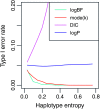Bayesian quantitative trait locus mapping using inferred haplotypes
- PMID: 20048050
- PMCID: PMC2845350
- DOI: 10.1534/genetics.109.113183
Bayesian quantitative trait locus mapping using inferred haplotypes
Abstract
We describe a fast hierarchical Bayesian method for mapping quantitative trait loci by haplotype-based association, applicable when haplotypes are not observed directly but are inferred from multiple marker genotypes. The method avoids the use of a Monte Carlo Markov chain by employing priors for which the likelihood factorizes completely. It is parameterized by a single hyperparameter, the fraction of variance explained by the quantitative trait locus, compared to the frequentist fixed-effects model, which requires a parameter for the phenotypic effect of each combination of haplotypes; nevertheless it still provides estimates of haplotype effects. We use simulation to show that the method matches the power of the frequentist regression model and, when the haplotypes are inferred, exceeds it for small QTL effect sizes. The Bayesian estimates of the haplotype effects are more accurate than the frequentist estimates, for both known and inferred haplotypes, which indicates that this advantage is independent of the effect of uncertainty in haplotype inference and will hold in comparison with frequentist methods in general. We apply the method to data from a panel of recombinant inbred lines of Arabidopsis thaliana, descended from 19 inbred founders.
Figures








Similar articles
-
A Multiparent Advanced Generation Inter-Cross to fine-map quantitative traits in Arabidopsis thaliana.PLoS Genet. 2009 Jul;5(7):e1000551. doi: 10.1371/journal.pgen.1000551. Epub 2009 Jul 10. PLoS Genet. 2009. PMID: 19593375 Free PMC article.
-
Bayesian model selection for multiple QTLs mapping combining linkage disequilibrium and linkage.Genet Res (Camb). 2014 Sep 19;96:e10. doi: 10.1017/S0016672314000135. Genet Res (Camb). 2014. PMID: 25579473 Free PMC article.
-
Bayesian modeling of haplotype effects in multiparent populations.Genetics. 2014 Sep;198(1):139-56. doi: 10.1534/genetics.114.166249. Genetics. 2014. PMID: 25236455 Free PMC article.
-
Bayesian mixture structural equation modelling in multiple-trait QTL mapping.Genet Res (Camb). 2010 Jun;92(3):239-50. doi: 10.1017/S0016672310000236. Genet Res (Camb). 2010. PMID: 20667167
-
Advances in Bayesian multiple quantitative trait loci mapping in experimental crosses.Heredity (Edinb). 2008 Mar;100(3):240-52. doi: 10.1038/sj.hdy.6801074. Epub 2007 Nov 7. Heredity (Edinb). 2008. PMID: 17987056 Free PMC article. Review.
Cited by
-
High-resolution genetic mapping using the Mouse Diversity outbred population.Genetics. 2012 Feb;190(2):437-47. doi: 10.1534/genetics.111.132597. Genetics. 2012. PMID: 22345611 Free PMC article.
-
New Rodent Population Models May Inform Human Health Risk Assessment and Identification of Genetic Susceptibility to Environmental Exposures.Environ Health Perspect. 2017 Aug 15;125(8):086002. doi: 10.1289/EHP1274. Environ Health Perspect. 2017. PMID: 28886592 Free PMC article. Review.
-
Measurement of serum PON-3 concentration: method evaluation, reference values, and influence of genotypes in a population-based study.J Lipid Res. 2011 May;52(5):1055-61. doi: 10.1194/jlr.D014134. Epub 2011 Feb 17. J Lipid Res. 2011. PMID: 21335322 Free PMC article.
-
Genetic analysis of complex traits in the emerging Collaborative Cross.Genome Res. 2011 Aug;21(8):1213-22. doi: 10.1101/gr.111310.110. Epub 2011 Mar 15. Genome Res. 2011. PMID: 21406540 Free PMC article.
-
Identification of new loci involved in the host susceptibility to Salmonella Typhimurium in collaborative cross mice.BMC Genomics. 2018 Apr 27;19(1):303. doi: 10.1186/s12864-018-4667-0. BMC Genomics. 2018. PMID: 29703142 Free PMC article.
References
-
- Bardel, C., P. Darlu and E. Genin, 2006. Clustering of haplotypes based on phylogeny: How good a strategy for association testing? Eur. J. Hum. Genet. 14 202–206. - PubMed
-
- Excoffier, L., and M. Slatkin, 1995. Maximum-likelihood estimation of molecular haplotype frequencies in a diploid population. Mol. Biol. Evol. 12(5): 921–927. - PubMed
-
- Gelman, A., J. B. Carlin, H. S. Stern and D. B. Rubin, 2004. Bayesian Data Analysis, Ed. 2 (Texts in Statistical Science). Chapman & Hall/CRC, London/New York/Washington, D.C./Boca Raton, FL.
-
- Haley, C. S., and S. A. Knott, 1992. A simple regression method for mapping quantitative trait loci in line crosses using flanking markers. Heredity 69 315–324. - PubMed
MeSH terms
Grants and funding
LinkOut - more resources
Full Text Sources

